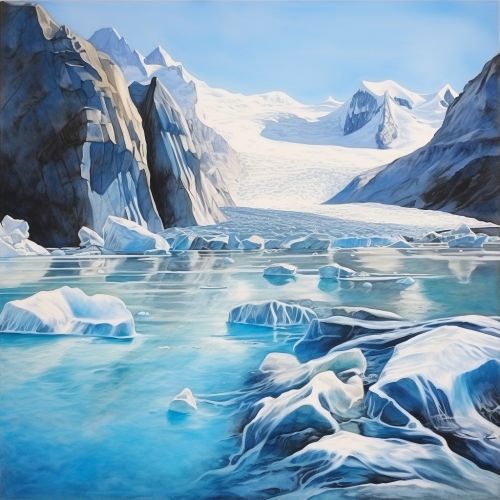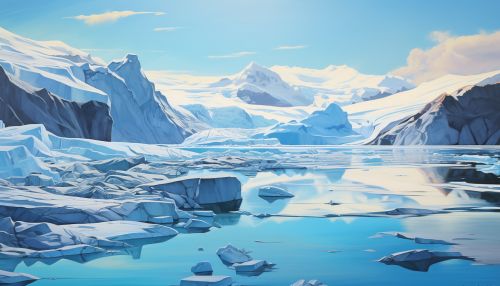Glacial Melting
Introduction
Glacial melting refers to the process where glaciers, large bodies of dense ice, lose mass due to melting and sublimation. This process is a significant aspect of the global water cycle and plays a crucial role in the distribution of the Earth's freshwater reserves. Glacial melting is influenced by various factors, including atmospheric temperature, solar radiation, wind speed, and the physical characteristics of the glacier itself.
Glacial Formation
Glaciers are formed through the accumulation and compaction of snow over many years. The process begins with the accumulation of snow in areas where winter snowfall exceeds summer melt. Over time, the accumulated snow transforms into firn, a granular type of snow, through a process called nivation. As the firn continues to accumulate, the weight of the overlying snow compresses it into solid ice, forming a glacier.
Factors Influencing Glacial Melting
Glacial melting is primarily influenced by climatic conditions, particularly temperature and precipitation. However, other factors such as the glacier's altitude, aspect, size, and the presence of debris on the glacier surface can also impact the rate of melting.
Temperature
Temperature is the most direct factor influencing glacial melting. When the atmospheric temperature rises above the freezing point, the ice in the glacier begins to melt. The rate of melting increases with the temperature, leading to a faster loss of glacial mass during warmer periods.
Solar Radiation
Solar radiation, or sunlight, is another significant factor influencing glacial melting. The amount of solar radiation reaching the glacier surface determines the amount of heat available to melt the ice. Glaciers in areas with high solar radiation, such as the equatorial regions, often experience higher rates of melting.
Wind Speed
Wind speed can also influence glacial melting. Strong winds can carry warm air over the glacier surface, increasing the temperature and promoting melting. Additionally, winds can also transport dust and other particles onto the glacier, darkening the surface and increasing its absorption of solar radiation.
Physical Characteristics of the Glacier
The physical characteristics of the glacier, such as its altitude, aspect, and size, can also impact the rate of melting. Higher-altitude glaciers are typically colder and receive more snowfall, reducing their rate of melting. Similarly, glaciers with a northern aspect (in the Northern Hemisphere) or a southern aspect (in the Southern Hemisphere) receive less solar radiation and therefore melt more slowly. Larger glaciers also have a lower surface-to-volume ratio, which can reduce the rate of melting.
Impacts of Glacial Melting
The melting of glaciers has significant impacts on both local and global scales. These impacts include changes in sea level, alterations to freshwater availability, and effects on local ecosystems.
Sea Level Rise
One of the most significant global impacts of glacial melting is sea level rise. As glaciers melt, the water they contain is released into the ocean, increasing the overall volume of the ocean and causing the sea level to rise. This can lead to coastal flooding and the loss of coastal habitats.
Changes in Freshwater Availability
Glaciers are a significant source of freshwater, providing water for drinking, irrigation, and hydroelectric power. As glaciers melt, the amount of freshwater they provide can fluctuate, leading to potential water shortages in areas that rely on glacial meltwater.
Effects on Local Ecosystems
Glacial meltwater also plays a crucial role in local ecosystems, providing a source of cold, nutrient-rich water for many species. Changes in the amount and timing of glacial melt can disrupt these ecosystems, potentially leading to declines in biodiversity.
Mitigation and Adaptation Strategies
Given the significant impacts of glacial melting, various mitigation and adaptation strategies have been proposed to address this issue. These strategies include reducing greenhouse gas emissions, implementing water management strategies, and protecting and restoring natural ecosystems.
Reducing Greenhouse Gas Emissions
Reducing greenhouse gas emissions is a key strategy for mitigating glacial melting. This can be achieved through a variety of measures, including transitioning to renewable energy sources, improving energy efficiency, and promoting sustainable land use practices.
Water Management Strategies
Adapting to changes in freshwater availability due to glacial melting requires effective water management strategies. These may include improving water storage and distribution infrastructure, promoting water conservation, and developing alternative water sources.
Protecting and Restoring Natural Ecosystems
Protecting and restoring natural ecosystems can also help to mitigate the impacts of glacial melting. Healthy ecosystems can provide a range of services that help to buffer against changes in water availability, including water filtration, flood control, and habitat provision.
See Also


